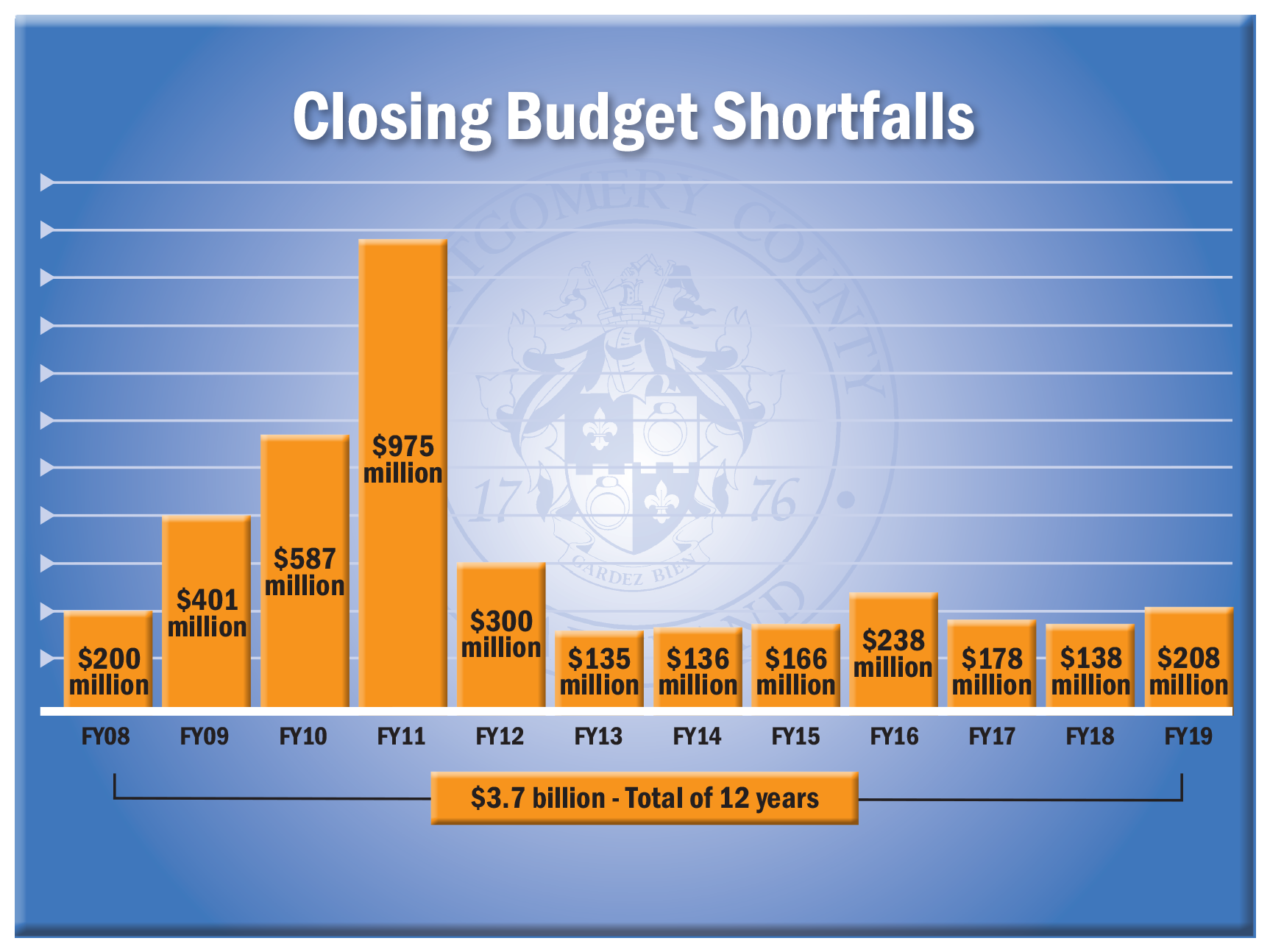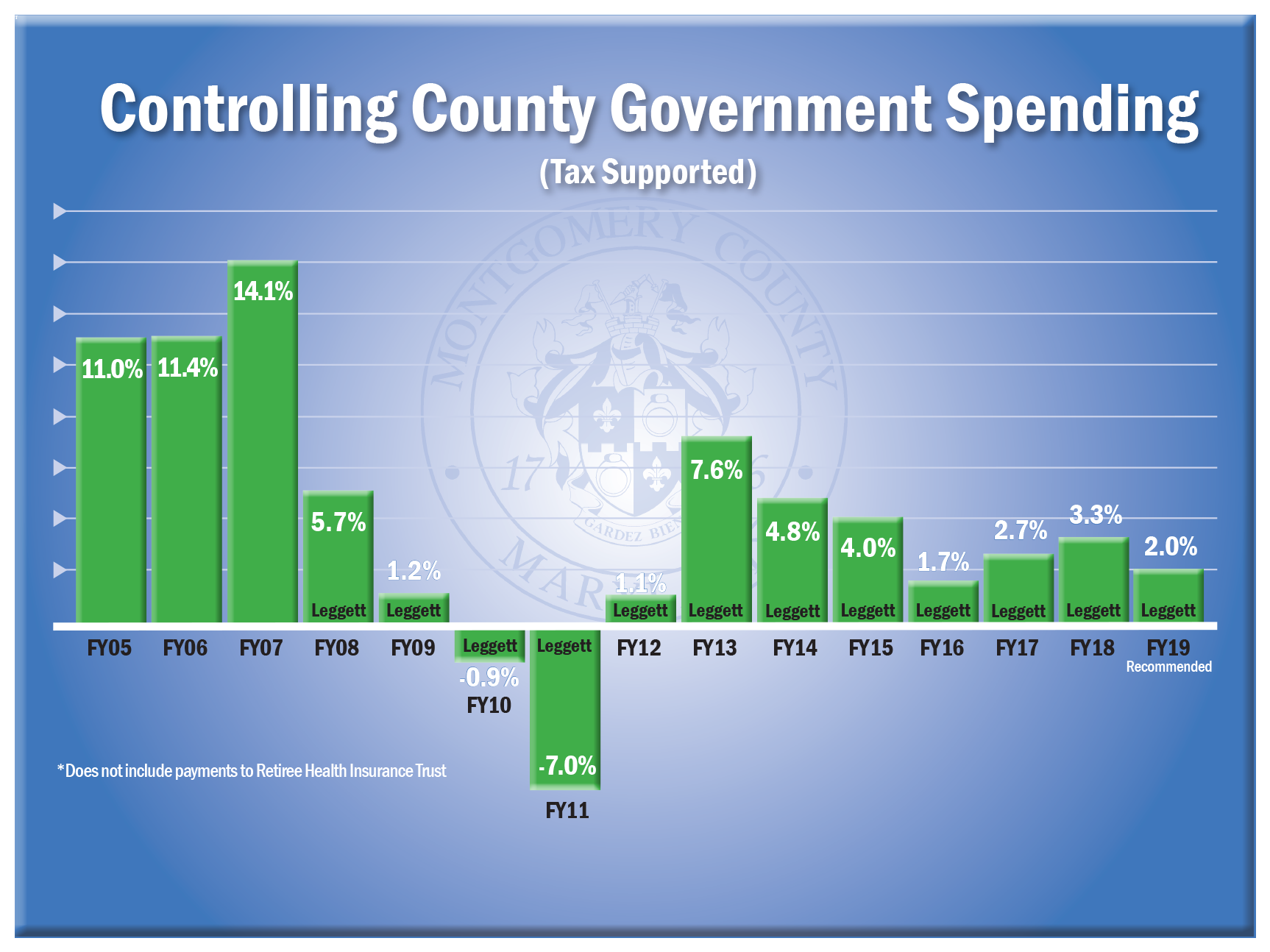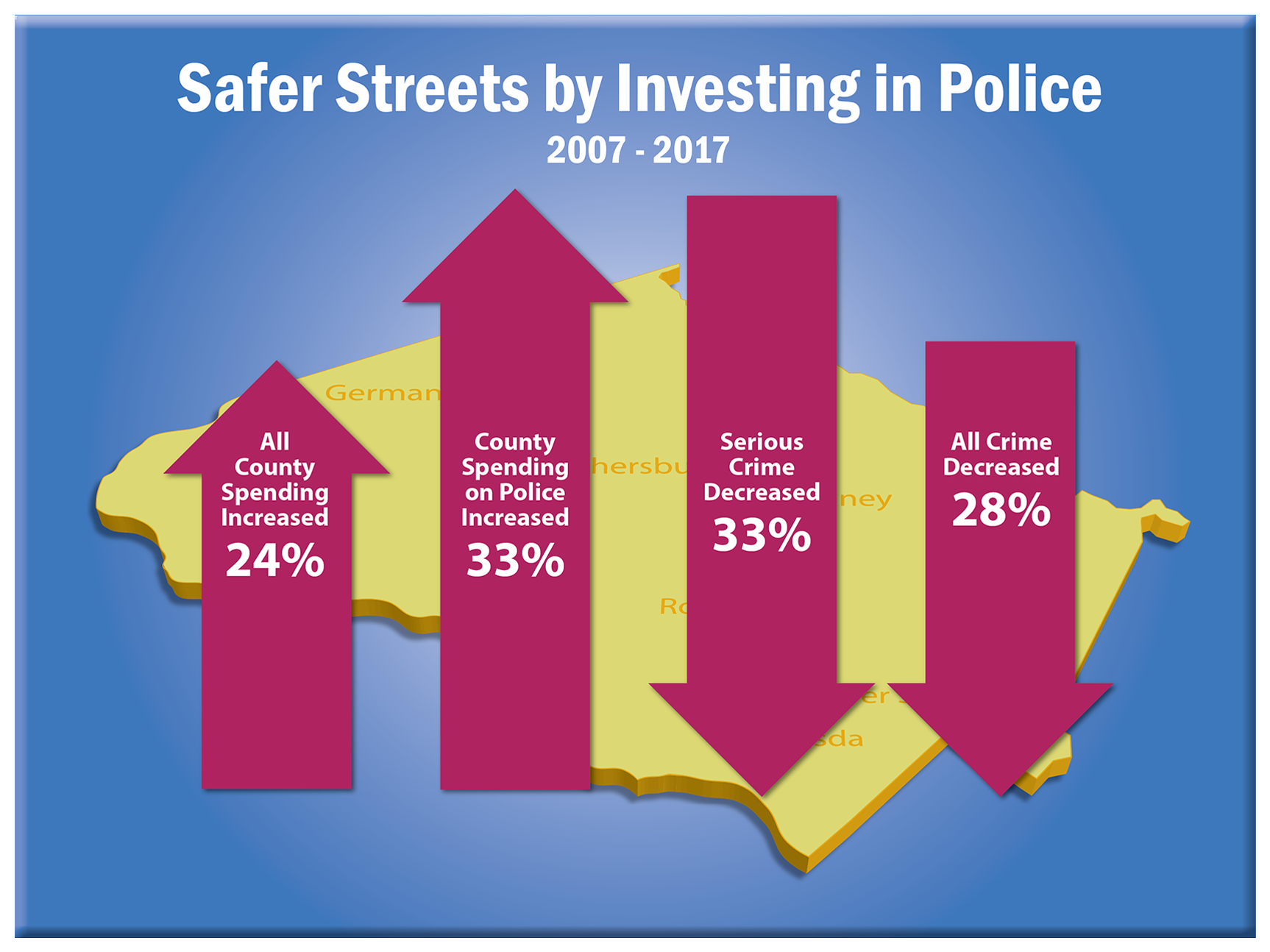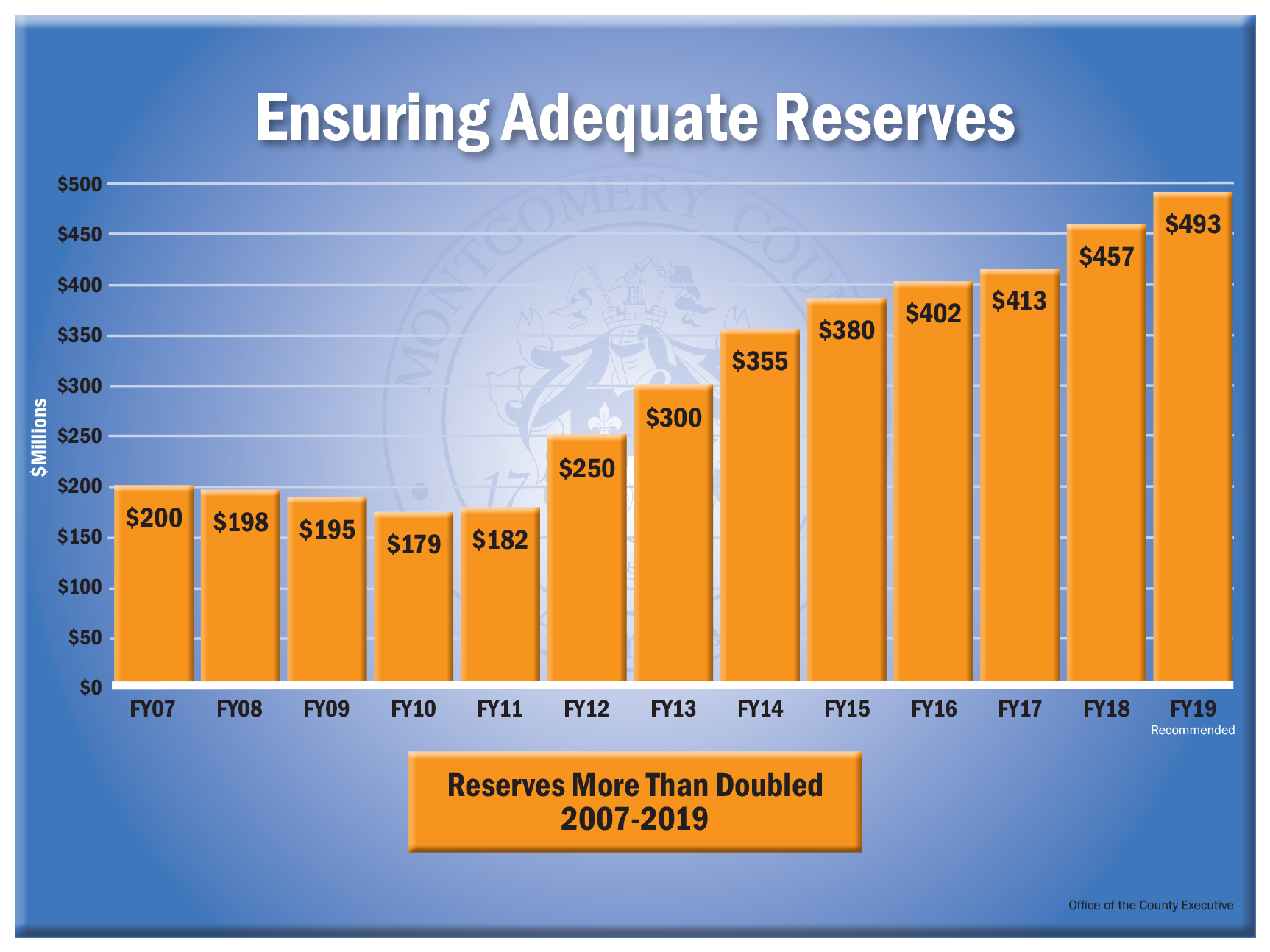Press Releases
Leggett’s Final Operating Budget for FY19 Closes $208 Million Gap; Funds 100 Percent of Schools Request; Holds Line on Property Taxes
For Immediate Release: Thursday, March 15, 2018
County Executive Ike Leggett today released his Recommended FY19 Operating Budget of $5.56 billion for the year that begins on July 1, 2018 – a budget that increases County spending on the Montgomery County Public Schools (MCPS) by $75 million and holds property taxes at the Charter Limit by reducing the tax rate by 1.98 cents per $100 assessed valuation.
“Over the last 12 years, I have closed $3.7 billion in budget gaps while putting the County’s fiscal house back in order and making the investments necessary to build a better future,” said Leggett.
“Even in the depths of the Great Recession and the ensuing fitful recovery, we have invested in providing our community with quality educational opportunities and improved public safety. We are working to meet the housing needs of our growing population, ensure that our senior population can age in place, and welcome our diverse immigrant community. We are growing our economic base with quality jobs and revitalized neighborhoods, funding cutting edge environmental and energy programs and policies, expanding transportation services and infrastructure, and providing an accountable and transparent government.
“The hard work of fiscal responsibility is not complete. This budget provides a blueprint for a sustainable and comprehensive fiscal future for the County. It reflects a balanced approach to meeting the growing needs of our diverse communities and robust business sector while keeping faith with County taxpayers.”
Leggett’s FY19 total budget increases spending overall by only 2 percent. The budget increases funding for the Montgomery County Public Schools by 3.1 percent, funding 100 percent of the Board of Education’s request. The $75 million increase over the current year’s budget is $19 million more than the required Maintenance of Effort level.
County government spending is actually reduced over the current year’s level by 0.5 percent. The recommended budgets for Montgomery College and the Maryland-National Capital Park & Planning Commission each rose by 0.8 percent.
Under the FY19 Recommended Operating Budget, the proposed property tax rate is 98.1 cents per $100 of assessed valuation – 1.98 cents below the current rate. The median tax bill (for a house assessed at $400,000) will see an annual increase of only $27 from $4,005 currently to $4,132 in the coming year. This amounts to $2.25 a month. It includes a $692 tax credit for owner-occupied residences.
“This budget continues my commitment to prudent fiscal policies critical to sound fiscal management,” said Leggett. “I have increased our reserve levels to cushion the taxpayer against any future unanticipated economic setbacks and included the required level of funding for retiree health benefits.
“At the same time, I have focused available resources on priorities that meet the important needs of our growing community. I have increased funding for public education at all levels beyond what is required by State Maintenance of Effort laws, funded our public safety needs, expanded our Positive Youth Development programs, provided resources for programs critical to our growing senior population and immigrant communities, and continued to address the needs of our most vulnerable residents.”
Leggett emphasized the results from County investment in public safety.
“Since 2007, I have added 132 police officers to the Montgomery County Police Department. While County tax-supported spending went up 24 percent over the past 11 years, I made sure our Police budget rose by nearly 33 percent. The result? Serious crime is down an astounding 33 percent between 2007 and 2017 and all crime is down 28 percent. And all this is while our population has gone up by 11 percent over that same time.
“We opened five new stations for County Fire & Rescue in the past 12 years, several in our growing Up County – compared to only one opened in the 12 years before I took office. And we added 64 positions to staff those stations.
“Response times from 911 call to arrival for Advanced Life Support have improved dramatically. In urban parts of the County we have seen a 29-percent drop in response time between 2007 & 2017. In suburban areas, we have reduced response times by 25 percent and in rural areas by 19 percent. In 2007 we had 13 fire-related deaths. In 2008, we had nine. By 2017 that number was down to three for the whole year.”
Leggett also touted the gains in fiscal stewardship over his 12 years.
“Tax-supported County spending over 12 years rose less than 3 percent annually,” said Leggett. “That is less than a one percent annual increase if you figure in inflation. When I was elected to this office, County spending had increased during each of the previous four years by an average of more than 10 percent – an astounding 42 percent over four years. That was not sustainable.”
Between 2007 and 2018, all County taxes as a percentage of residents’ income went down by 5 percent. Property taxes for the average home, adjusted for inflation, rose only a total of 11.6 percent over 12 years – less than one percent a year. While the County’s population rose by 11 percent over those 12 years, the number of County employees increased by only 2.6 percent. County reserves rose from $200 million in 2007 to $457 million in the FY19 recommended budget.
Operating Budget highlights FY19 and the years before include:
· $2.59 billion for Montgomery County Public Schools. Since FY07, the County has provided MCPS with increases totaling $349.7 million, while per-pupil expenditures have grown by 18.2 percent since FY08. During that time total enrollment has grown by 25,386 students or 18.4 percent. The student population has become more diverse and experienced a growth in the number of students qualifying for Free and Reduced Meals (FARMS). From 2007 to 2017, the number of English language learners have grown by 76 percent and FARMS students by 63 percent. Since Leggett took office, thirteen new school facilities have been added, as well as 21,043 new classroom seats. The County has invested over $246.2 million in new technology for our student population over the last twelve years, ensuring they have the modern tools necessary to learn and compete in our technology-driven world.
County Executive Leggett led the fight to expand State funding for the County’s critical school construction needs. Working with the County’s delegation and building coalitions with other jurisdictions, the County won more than $472 million in State school construction aid over the last 11 years, including $59 million for the current year.
· $313 million in funding for Montgomery College. Funding for Montgomery College increased by 61.9 percent on a per-pupil basis since the FY07 operating budget, providing new programs and resources to those choosing to continue their education in one of the finest community colleges in the nation. With County funding, the College has opened new and modern facilities for science, math, student services, arts, and social sciences. In addition, the Takoma Park/Silver Spring campus expansion was completed, which nearly doubled its size.
· Reserves. Since taking office as County Executive, Leggett has overseen the shoring up of County finances by increasing reserves from $77.6 million (2.1 percent) in FY10, during the depths of the Great Recession, to $492.6 million (9.4 percent) proposed for FY19. The County remains on track to achieve the 10 percent reserve goal by FY20. A substantial reserve is essential to weathering unexpected economic downturns. Additionally, the County is complying with the prefunding requirements for retired County employee health benefits laid out by GASB, with a prefunding contribution of $132.9 million in FY19.
· Affordable housing. The FY19 Recommended Operating Budget adds $51.6 million to the County’s affordable housing commitment, bringing total investment in affordable housing since FY08 to over $1 billion, an average of approximately $84 million per year. This funding has enabled the County to preserve and create nearly 70,000 affordable housing units. Despite the upheaval in the nation’s financial markets, the County funds have leveraged another $1 billion in housing development and rehabilitation resources from other sources, including the private sector. The total County resources are in the FY19 budget are equivalent to Leggett’s stated goal of 2.5 percent of property tax revenue. Through strategic partnerships with the for-profit and non-profit development community, the County has developed 17 senior housing projects, producing or preserving 2,100 units, including approximately 1,700 units affordable to seniors at or below 60 percent of the area median income. During Leggett’s 12 years, the County has dedicated $71 million for senior housing while leveraging $363 million in other non-County financing.
Montgomery County’s program to prevent housing foreclosures has helped thousands of County residents and is a national model. And, under Leggett’s leadership, the one-third of County residents who are County renters got “a seat at the table.” The County has provided resources to enhance landlord-tenant outreach, building inspections, tenant protections, and housing code enforcement.
· Public Safety. The Recommended FY19 Operating Budget includes $1 million in additional funds for the Criminal Street Gang Units in both the Police Department and the State’s Attorney’s Office. These units will focus on the organized crime aspect of gang activity, allowing for more modern crime prevention and suppression approaches. Additionally, the County has made a significant investment in the acquisition, maintenance, and use of body-worn cameras in nearly all our law enforcement agencies. Overall, public safety agencies saw their budgets increase by nearly 26 percent over twelve years. The County added District Community Action Teams in each of the six Police districts. The acquisition of the new Public Safety Headquarters building and the co-location of administration for the County’s major public safety departments have allowed for better coordination and interaction between the departments while the new state-of-the-art Public Safety Training Academy has boosted training. With significant reductions in crime there are now, on average, 118 fewer individuals in the County jail on an average day than before Leggett took office.
The County also assumed responsibility for all animal control and adoption services with the construction of a modern County Animal Services and Adoption Center building. Leggett also established the Family Justice Center, providing individuals and families affected by domestic violence and child abuse a single location for assistance from the County and nonprofit organizations. The County also provided funding to the Courts for a monitoring and exchange center which ensures the safe exchange of children between estranged parents.
· Economic Development.Over the past decade, Montgomery County has witnessed steady job growth despite setbacks caused by the Great Recession. County investment in establishing a business innovation network since 2012 has attracted more than 60 early-stage and/or startup companies and created more than 275 new jobs to continuously support the growth of key strategic industries (i.e., biotech/life sciences, cybersecurity, health tech, etc.) in the County. This innovative business model has expanded the County’s biosciences and high-tech networks at all talent levels.
County Executive Leggett privatized the County’s economic development functions and workforce development to strengthen County efforts to market and develop target industries, to match trained workers with identified needs, and to retain and attract businesses and talent in the County. He provided leadership, planning, andresources to support the Great Seneca Science Corridor, the White Oak Science Gateway, and the White Flint Plan, as well as my Smart Growth Initiative and transit-oriented development around the Shady Grove Metro. Wheaton redevelopment is underway with the beginning of construction of a county office building/town square and a new combination library/recreation center.
Montgomery County adopted the first local biosciences tax credit in the nation and has supported BioHealth Innovation as a public-private partnership to better commercialize the important research being pioneered in the County. With State and federal support, the National Center for Cybersecurity Excellence was established to help better protect the businesses of today and tomorrow from cybersecurity threats.
Montgomery County has streamlined the County permitting process to cut months off our approval times, allow for electronic filings, and, in general, work to get projects approved, done, and on the County tax rolls – creating jobs – as soon as practicable.
Other economic development tools have included:
· MC Square - a set of new and expanding programs to build the County’s innovation ecosystem and foster entrepreneurship through strategic public private partnerships;
· MOVE (Make Office Vacancy Extinct) – a program designed to attract new businesses and reduce County’s vacant office space;
· ultraMontgomery – supports deployment and use of high-speed fiber networks to expand access to networks through public-private partnerships, and to attract knowledge-based employers, innovators and entrepreneurs in County’s target industries;
· Entrepreneur-in-Residence Program – partnered with BioHealth Innovation and other community stakeholders to support and attract startups and early-stage technology companies with technical mentorship and capital access to stimulate the County’s entrepreneurial growth; and
· Excellence in Business Services Initiative – an integrated business portal to streamline and improve the experience and perception of doing business in Montgomery County.
The FY19 budget includes a $300,000 increase in the County’s microlending program and a $250,000 increase in the Small Business Assistance program to assist Wheaton business owners during construction there.
To continue to support the vitality of Montgomery County as a business destination and a burgeoning innovation and tech-driven economy, The County has supported grants funded through the Economic Development Fund to retain and expand cooperate headquarters located in the County, including Marriott, Host Hotels & Resorts, United Therapeutics, JBG-smith, Fox 5 Television Station, and others.
· Accountable & Accessible Government.From the start Leggett established as a priority making County government more accessible, more accountable and more effective. He held more public “Town Hall” meetings in his 12 years than all other previous Montgomery County executives combined, in addition to holding more than 60 budget forums.
Leggett established CountyStat to provide real-time information and analytics on the performance of County services. CountyStat has saved the County millions of dollars since its establishment. The 311 Call Center has taken more than 4 million service requests over the past seven years, providing County residents with a single number to call and a ”live” voice on the other end.
The Leggett Administration has also worked to make sure that all companies – including those owned by women, minorities, and the disabled – have an equitable opportunity to do business with the County. The County has expanded County procurement to these vendors from $90 million in 2007 to $217 million in 2017 – a 140-percent increase.
· Transportation. The Leggett Administration has worked to expand County transportation options – in order to help County residents and their families and to support the growth of business and quality jobs. The County has developed and funded transit solutions in a number of corridors by focusing on transit-oriented development; expanding or adding bus routes; implementing transit improvements including bus rapid transit (BRT); development of transit centers in Silver Spring, Montgomery Mall, Takoma/Langley Park, and White Oak; non-vehicular transportation elements such as sidewalks, shared-use paths, bike lanes, and a bikeshare system which has expanded to 73 stations, supporting Purple Line construction, advancing traffic improvements around the National Naval Medical Center in Bethesda, and significantly increased funding levels for highway maintenance and road resurfacing programs.
Between 2007 and 2018, County funding for primary road maintenance increased by more than 136 percent and the amount spent on residential roads by 1,330 percent.
The recently-launched multi-departmental Vision Zero initiative, which is funded at $118 million in the FY19 budget, has a two-year goal of reducing severe and fatal traffic collisions by 35 percent with the long-term goal of eliminating such collisions by 2030. This builds on the County Executive’s Pedestrian Safety Initiative, established in FY10, through which 250 severe and 33 fatal collisions have been prevented. The County has seen pedestrian deaths in the County go from 19 deaths in 2008 to 8 in 2016 with a more than a 50-percent drop in collisions resulting in serious injuries. Seventeen “High Incidence Areas” (HIA) were identified and studied, with short-term improvements completed and many long-term improvements in progress. The Montgomery County Department of Transportation has constructed 30 miles of new sidewalk segments, completed more than 3,204 bus-stop improvements, and undertaken 1,282 new Americans with Disabilities Act ramps aimed at improving pedestrian safety. Areas with traffic calming improvements have seen pedestrian collisions decline by 44 percent, and education efforts in the HIAs have reduced pedestrian collisions in those areas by 52 percent.
Development continues on the US 29 and MD 355 BRT “Flash” corridors. The Flash will provide a new high-quality transit option in the County, making efficient use of existing roadways to provide a more robust and reliable system that will increase transit ridership. Final design on the US 29 Flash line will be completed in Fall 2018 with construction commencing shortly thereafter. Service is scheduled to begin in mid-2020. In the meantime, Ride On will operate a new overlay service to alleviate traffic congestion beginning in May 2018.
· The Safety Net.Over the past 12 years, the County has effectively achieved the goal of zero homelessness for veterans and the medically vulnerable and is working to end homelessness for chronically homeless single adults. In FY19, the County Executive is recommending $22.3 in homelessness programs The County has also expanded health care services for the uninsured and underinsured through the funding of the Montgomery Cares network of clinics and through services provided directly at County health clinics; strengthened our Maternity Partnership program; enhanced medical services for ethnic and cultural minorities through the African American Health Program, the Asian American Health Initiative, and the Latino Health Initiative; and ensured that individuals who are eligible for medical coverage under the Affordable Care Act are enrolled (the County has had the highest enrollment rates in the State for the past five years).
The Recommended FY19 Operating budget includes $17.2 million for developmental disabilities providers to pay direct service professionals at 123 percent of the County’s minimum wage. This is a year-over-year increase of $2.5 million. Of this enhanced funding, $1.3 million is directly related to the increase in the County’s minimum wage. The remainder due to an increase in the number of hours worked. In addition, as a result of the minimum wage increase, the County Executive is including over $800,000 to support adult medical daycare workers’ wages and almost $62,000 to support public service interns’ wages at the new minimum wage. The total increase in funding needed for these three groups as a result of the minimum wage increases in FY19 is $2.2 million. This total will continue to rise as the County minimum wage continues to increase.
The FY19 budget includes $359,000 for Mental Health Court expansion and an addition $1 million for school health services.
The FY19 Recommended Operating Budget continues to provide funding for the East County Opportunity Zone to create an opportunity for collaboration between the County and community partners to provide a menu of services to those most in need in the East County area. This budget adds an additional School Cluster project to our successful initiative in the Kennedy and Watkins Mill clusters. The new Cluster Project will be implemented in the Paint Branch and Springbrook High Schools. This program’s goal is to offer critical comprehensive services to help close the achievement gap for students.
During the Great Recession, the County reached out to establish Neighborhood Health Centers and also responded in a timely and effective way to such public health crises as the H1N1 and the Zika viruses.
And, once again this year, Montgomery has been recognized as Maryland’s healthiest county.
The FY19 budget also increases funding for the Montgomery Coalition for Adult English Literacy by $100,000.
· Seniors. The FY19 Recommended Budget includes approximately $38.5 million in tax- supported resources identified for seniors in Montgomery County, including funds for community organizations that augment County services for seniors and respond to the needs identified in the County Executive's 2015 Summit on Aging. In addition, the Recommended Budget includes $15.1 million in non-tax supported resources for seniors such as support from the Emergency Medical Transport Fee and Medicare/ Medicaid funding for health services and transportation.
In 2008, the County Executive convened a community summit with nearly 400 participants to inaugurate his Senior Initiative. One of the major accomplishments of this Summit was the creation of the Subcabinet on Senior Vital Living whose mission is to increase senior connectedness, community engagement, and knowledge of and access to available resources.
The County inaugurated a new Escorted Transportation Program for low-income adults with disabilities who require an escort for the duration of their trips which has served 337 residents for a total of 3,064 trips. In addition, the County initiated "Seniors Ride Free" on Metrobus and Ride On during non-peak hours, and began providing, in partnership with the Jewish Council for the Aging, free curb-to-curb transportation service to residents living within a three to five-mile radius of the County's senior centers.
In 2015, the County enrolled in the American Association of Retired Persons (AARP)/World Health Organization (WHO) Age-Friendly Communities Network and earned designation as an "Age Friendly Community." The initiative provides a framework for developing a comprehensive approach toward ensuring that the needs of older adults and all County residents are recognized and acknowledged. In partnership with BrightFocus Foundation, the County enrolled in the Dementia Friendly America Initiative. This national initiative fosters the creation of communities that better recognize and help those affected by dementia, their families, and care partners.
· Positive Youth Development. The FY19 Recommended Budget includes $27.3 million for the County Executive’s Positive Youth Development (PYD) programs. PYD was founded by Leggett as part of a new coordinated vision regarding the increasing need to provide our school-age youth with positive activities that would help prevent criminal activity, promote educational attainment, and enhance the opportunities available to our youth. Programs have been funded through several County departments including, the Recreation Department, Health and Human Services, the Police Department, and the State’s Attorney’s Office. These programs have had an impact on the lives of thousands of our youth over the last 12 years and have helped lower truancy rates, prevented youth from engaging in negative behaviors, provided recreational and learning opportunities, and provided critical social services for vulnerable youth.
· Libraries. In 12 years, County Executive Leggett opened four new or renovated libraries, refreshed six libraries, expanded library hours, increased the materials budget, provided more than $2.6 million for modern technology infrastructure, and expanded library offerings to include electronic media. Circulation of all materials has grown to more than 11.8 million annually. Since the depths of the Great Recession, the County has increased funding for the Department of Public Libraries by over 50 percent. The FY19 Recommended Operating Budget includes $42.9 million for the Department, a slight increase of 0.3 percent from their FY18 approved budget.
· Environment. Montgomery County has long been a leader in the area of environmental policies and programs. Montgomery County was the first jurisdiction in the State to receive a NPDES permit under the Maryland Stormwater Act of 2007. The County is currently working toward meeting the requirements of the third-generation permit issued in 2010. Already 2,927 impervious acres have been restored, achieving 77 percent of the restoration goal. The County has spent well over $100 million on water quality goals. The FY19 operating and capital budgets increase this investment to $55.3 million in FY19 and $75.2 million in capital expenditures from FY20 through FY24.
The County established the Residential Energy program to assist residents, including low-income residents, reduce their energy costs and greenhouse gas emissions through implementation of energy efficiency and renewable energy measures. County Government also is leading the way by reducing the combined annual greenhouse gas emissions of County buildings and fleets through the purchase of electricity generated by clean energy technologies, solar energy installations on County facilities, building efficiency initiatives, improved fleet vehicle mileage and fleet alternative fuel use. To assist the private sector in these same goals, the Department of Finance and DEP developed a Commercial Property Assessed Clean Energy (PACE) program, which will allow commercial property owners to borrow money for energy efficiency improvements and renewable energy projects and repay the loan via their property tax bill.
The County installed a new system to reduce nitrogen oxide emissions by half at the County’s Resource Recovery Facility. The County has also increased it’s already broad recycling efforts with a goal of reaching a 70 percent recycling rate by 2020. Currently 61 percent of all municipal solid waste is recycled. The FY19 Operating Budget includes a new Commercial Organics Recycling Program designed to increase commercial recycling and will help determine the viability of extending the effort to residential properties.
The County is the biggest local government purchaser of renewable energy east of the Mississippi. Solar installations on County buildings will save taxpayers tens of millions of dollars in energy costs going forward. All County buildings are now constructed “green.” And the County’s reusable bag law is helping to keep plastic and paper bags out of our waterways and from alongside our roadways.
The full budget and highlights are available on the County’s website at: http://montgomerycountymd.gov/operatingbudget.
Following are the links for the FY2019 Budget Charts:
 |
 |
 |
 |
 |
 |
# # #
Media Contact: Patrick Lacefield 240-777-6528
